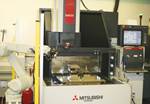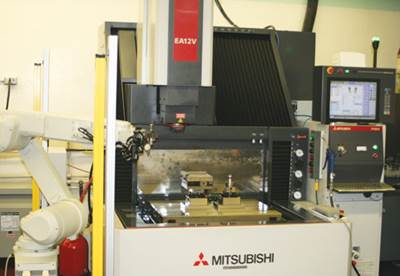New EDM Pushes Performance and Precision
“This machine has changed wire EDM in a way that the machines I’ve operated have not been able to do, because it cuts substantially faster than its predecessors, yet it consumes about 40 percent less wire.”
Pushing technology to the edge is standard operating procedure for NyproMold in Gurnee, IL. Recently Pete Smith, Group Leader EDM-WEDM-Graphite, explained how the addition of a new EDM machine—the Mitsubishi MV1200-R Advance Plus—helped the shop reach new heights of efficiency and performance. “I’m very impressed; it’s a fun machine to run,” Smith says. “Processing speeds are so much more advanced than even five years ago, and it has made a big difference for us.”
Founded in 1987, NyproMold builds plastic injection molds for the healthcare, packaging, consumer, and electronics markets. The company has two facilities: the 35,000-square foot Gurnee facility boasts the same high-level capabilities as the larger headquarters facility in Clinton, MA.
More than 50 percent of the shop’s work serves the medical industry, and that tight-tolerance work is a differentiator for the company. “Our facility manufactures molds ranging from one cavity, all the way up to 128 cavities or more. We pride ourselves on being able to quickly accommodate part changes from our customers—we can make a whole new stack of components, and they’re completely compatible with the existing mold frame. The only way you can do that is if you’re able to hold tight tolerances,” Smith explains.
Because Mitsubishi’s MV series EDM machines feature the latest technology in auto-threading, internal machine communication, power supply and operating cost reduction, it seemed like a great fit with NyproMold’s focus on giving customers high performance. At the 2012 IMTS show, the company purchased three of the MV1200-R Advance Plus wire EDM machines: two for the Clinton location and one for Gurnee.
The MV 1200 R’s non-contact cylindrical drive system makes it possible to reach a new level of precision, Smith reports. “We can cut pockets and different tapers that a lot of machines can’t cut with conventional machining,” he says. “The motors are literally running on magnets, without the wear issues of running on ball screws, like traditional machines. It is able to hold a much more precise positioning.”
The machine’s automatic feed adjustment has been another huge advantage, says Smith. “Any time you’re using a wire EDM, there’s a feedback factor. When the wire gets too close to the material or starts to pull too far away as you’re cutting, your feedrate needs to adjust,” he explains. “The quicker you can respond to that—and we’re talking milliseconds—the more consistent your cut is going to be, and the faster you’ll cut because you’re cutting as efficiently as possible. This machine has changed wire EDM in a way that the machines I’ve operated have not been able to do, because it cuts substantially faster than its predecessors, yet it consumes about 40 percent less wire.”
Down to the Wire
That lower wire consumption, coupled with faster operation and wire recycling, is a winning equation for Smith. “The newer machines chop wire instead of just spooling it out like angel hair, so you get a bit more money back when recycling,” he says. “It’s not a new technology, but it does make it easier to handle. We pay about $6/lb. for wire, and our recycling yields around between $2.85 and $3.15/lb., so we’re getting almost half the money back; and by using less wire, the profitability is going up substantially. I get 50 percent back by recycling, plus about twice as much work done with the same amount of wire, and getting it done faster. There are no negatives there.
“Plus, the threading mechanism is far superior to any other I’ve experienced,” Smith adds. “Anyone who has run a wire for a long time knows that to get your unattended running time, the machine needs to thread independently while you’re home in bed. Let’s say the part has 100 holes, when you come in in the morning, you don’t want the machine to have missed 60 out of 100. You want it to have threaded every one.”
Smith was able to witness the MV 1200 R’s advanced threading system when he stopped by the shop over a long weekend to put a new spool of wire on the unattended machine. “The wire had broken in the middle of a cut. Normally when that happens it can be difficult to retrace that path, but this machine actually rethreaded right through the cut.”
Smith cites the machine’s high capacity as a deciding factor when selecting the MV 1200 R. At the time, NyproMold had taken on some jobs projecting a very high volume of wire time, and the new machines helped the company deliver on time, with great results.
Final Advice
Smith says that just 10 years ago he suspected that EDM technology had gone about as far as it could. “We would joke that ‘it’s just a 10-thousanth wire, there’s only so much electricity you can put into it.’ But I didn’t realize how much the computing side of it had been holding EDM back,” he says. “I think there’s been a kind of ‘Aha! moment’ in the application of technology. Machine manufacturers began to look at not only how we’re generating the spark, but also how we’re responding to the spark. We were not responding quickly enough. The result has been the better threading capability, the increased processing speed. I will never doubt again how far technology can go.”
He offers this example. “I’ve got an EDM machine that we bought in 2010. We did some time trials and, at the time, that machine cut about 30 percent faster than our previous machine, which we’d purchased in 2006. That is a pretty big jump in just four years. Our new Mitsubishi wire EDM cuts about 30 percent faster than that. The technology basically obsoleted our 2010 machine. And that’s just a two-year period for the same increase.”
Smith says that service is a key factor when buying a new EDM. “Because of the economy, some manufacturers seem to have made major cuts in their service area. In my opinion, service is huge. If your machine goes down you’re not just not making money, you’re losing money. Mitsubishi does a great job. They have an outstanding training program.”
Finally, Smith recommends that moldmakers shopping for an EDM look for “bang for the buck”–that perfect balance of profitability and accuracy. He concludes, “There are machines out there that might be able to cut with even higher precision, but they cost three times as much. It really depends on your shop’s needs.”
www.nypromold.com
(978) 365-4547
Related Content
MMT Chats: Injection Molds and Integrated Solutions Through Ambition and Innovation
Jordan Robertson, VP, Business Development and Marketing for StackTeck discusses various mold technologies to improve efficiencies in automation, cooling, lightweighting and sustainability.
Read MoreInnovative Mold Building Enhances Packaging Material Efficiency, Elevates Recyclable Design
A manufacturing-focused design and optimized tooling enhance material efficiency in packaging for a new medical instrument.
Read MoreHammonton Mold, ADOP France Forge Strategic Partnership in Injection Blow Moldmaking
Hammonton Mold Inc., a leading full-service mold shop based in New Jersey specializing in injection blow molds (IBM), proudly announces its official partnership with ADOP France, a prominent IBM mold manufacturer based in Normandy, France.
Read MoreR&D Drives Innovation and Problem-Solving at Michigan Blow Mold Builder
Mid-America Machining focuses on reshaping designs, “right weight" initiatives, continuous improvement and process refinement to enhance moldmaking efficiency.
Read MoreRead Next
Equipment Investment Allows Moldmaker to Zero in Medical/Packaging Niches
Tech Mold Inc. (Tempe, AZ)—a manufacturer of high-volume, multi-cavity molds for the medical disposable, packaging (caps and closures) and consumer markets—has invested just under $1,000,000 on new equipment over the past six months. These new capabilities have allowed the company to refocus its efforts in the medical and packaging markets.
Read MoreReasons to Use Fiber Lasers for Mold Cleaning
Fiber lasers offer a simplicity, speed, control and portability, minimizing mold cleaning risks.
Read More



















